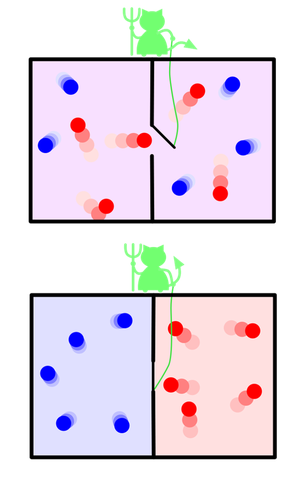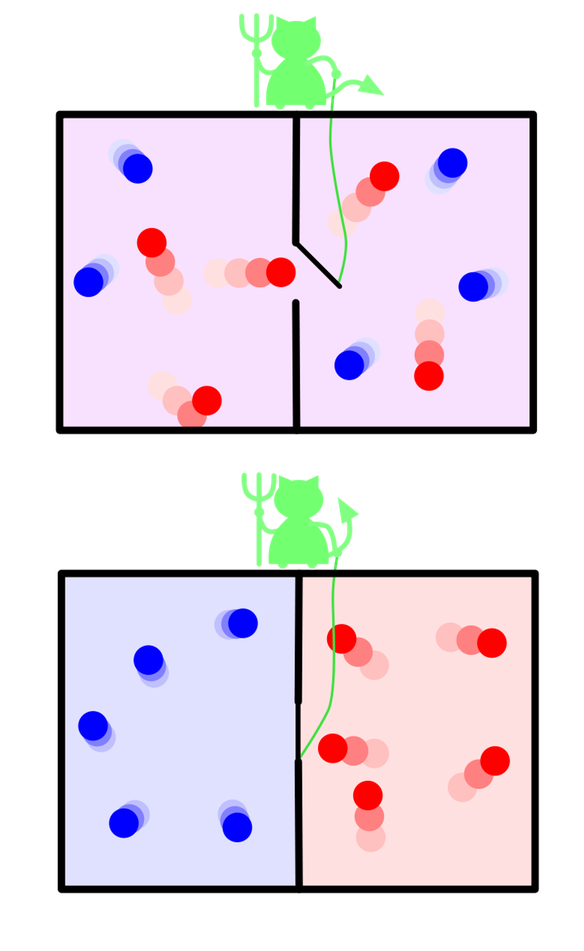Maxwell’s Refrigerator, Powered by Information
In a th century thought experiment, Maxwell’s demon was a character who could use an ability to sort hot molecules from cold ones to apparently flout the second law of thermodynamics—the rule that the total entropy of a system never decreases. Now in Physical Review Letters a team outlines a scheme to construct a physical device that acts like Maxwell’s demon. It doesn’t violate the second law because it generates entropy by manipulating digital information. And even though it requires no energy input, the device can act like a refrigerator—a machine that moves energy from a cold region to a hot one. If it can be built, the device could test the current understanding of the relationship between information and entropy.
The second law states that no process can transfer heat from a cold to a hot system—thereby decreasing entropy—without increasing entropy somewhere else. Yet physicist James Clerk Maxwell imagined that a tiny, intelligent being could do just that by controlling a door in the partition inside a box filled with a gas. This demon could let faster, “hotter” molecules through to one side of the box and restrict slower, “colder” ones to the other side, generating a temperature difference between the two sides. The demon didn’t appear to increase entropy anywhere.
But today most researchers agree that because there is entropy embodied in information, the demon’s thought processes would produce enough entropy to make up for the gas’s entropy decrease, as proposed by theorist Rolf Landauer in 1961 [1]. If one could make such a demonlike device, it could test Landauer’s theory and also examine just how computation is linked to classical ideas in thermodynamics, says Christopher Jarzynski of the University of Maryland in College Park.
Last year, Jarzynski and graduate student Dibyendu Mandal proposed such a “minimal model” of a demonlike device [2]. It could turn energy from a heat bath into mechanical work, such as lifting a weight, even though this process decreases entropy. To compensate, the device’s operations were linked to the flipping of bits in a memory register, essentially using information entropy to “pay” for the extracted work.
In collaboration with their colleague Haitao Quan, now at Peking University, Mandal and Jarzynski have now refined their model to mimic the function of the classic Maxwell demon. The new demon has two energy states between which it can jump by exchanging energy with a hot and a cold reservoir. As in the earlier version, the demon is governed by rules that couple these transitions between states to the flipping of bits in the memory. This simpler model allowed the researchers to map out the different regimes of behavior for different model parameters, showing that it can operate either as a refrigerator or as an information eraser.
As before, the memory is an infinite “tape” imprinted with digital data, and each bit interacts with the demon for a fixed time before the tape moves over by one bit. During the interaction time, the demon makes random transitions between its two energy states based on the temperatures of the reservoirs and on the bit value, according to a set of rules. The rules say that energy may only be absorbed from the cold reservoir if the incoming bit is a , or released into the cold reservoir if the bit is a . And whenever energy is exchanged with the cold reservoir, the demon reverses the bit, which affects the entropy of the outgoing bit stream. Energy exchange with the hot reservoir is unaffected by the bit values. So each allows the chance for energy to move from the cold reservoir into the demon and out to the hot reservoir.
Although the incoming bits must be statistically uncorrelated, ’s and ’s need not appear with equal probability. The team shows that if there are enough ’s, and the reservoir temperature difference isn’t too great, the demon is a refrigerator (it moves energy from cold to hot). On the other hand, if the incoming bits include enough ’s, or if the temperature difference is large enough, the demon works in reverse—it erases information from the tape, reducing its entropy, while allowing energy to flow from hot to cold.
As for building such a system, “We are exploring a fully mechanistic Rube Goldberg-like contraption” involving rotating wheels and paddles, says Jarzynski. Designing a working Maxwell demon is “an important task,” says Franco Nori of the University of Michigan in Ann Arbor. “This is a very important step in the right direction.”
–Philip Ball
Philip Ball is a freelance science writer in London. His latest book is How Life Works (Picador, 2024).
References
- R. Landauer, “Irreversibility and Heat Generation in the Computing Process,” IBM Journal of Research and Development 5, 183 (1961)
- D. Mandal and C. Jarzynski, “Work and information processing in a solvable model of Maxwell’s demon,” Proceedings of the National Academy of Sciences 109, 11641 (2012)





